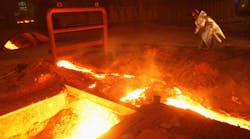Iron ore bears are unconvinced that a record jump in prices amid renewed optimism over China’s economy signals a sustained rebound in the steel-making raw material.
The 19% surge Monday came after Chinese policy makers indicated their willingness to bolster economic growth, boosting the outlook for steel and igniting speculation that some investors who had bet against the market had been caught out. Citigroup said it’s still bearish as supply and demand fundamentals remain weak while Axiom Capital Management Inc. said the price jump was probably just a “blip”.
“The issue is that China is exposed to a global economy whose growth is mediocre at best, and driving domestic demand is becoming more difficult than ever,” Jessica Fung, an analyst at BMO Capital Markets in Toronto, said by e-mail. “I am concerned that this is setting China up for a harder landing down the road, which in turn means a very strong reversal for iron ore prices.”
Iron ore has powered higher in 2016 as steel prices strengthened, undermining forecasts for further losses driven by mounting low-cost supply from Australia and Brazil and weakening demand in China. The pace gathered momentum as Chinese mills began to ramp up output after the Lunar New Year break in February, a tropical cyclone in January that disrupted some shipments from Australia, and China moved to boost the economy.
Ore with 62% content delivered to Qingdao rose to $63.74 per dry metric ton on Monday, Metal Bulletin Ltd. data show. That was the biggest gain in daily data going back to 2009 and the highest price since June.
“There’s clearly what you would describe as an extreme short-covering event going on,” Wayne Gordon, executive director for commodities and forex at UBS Wealth Management, told Bloomberg. “To me, the rally is there to be sold, because the fundamentals of the market, being supply and demand, do not stack up to the sharp movements we’ve seen.”
The advance is already showing signs of easing. While futures in Dalian were still limit up on Tuesday, prices on the Singapore Exchange were down 6.3% at $54.94 per ton by 11:59 a.m. local time. China’s demand for iron ore weakened in February with imports sliding to 73.61 million tons from 82.19 million tons a month earlier and the lowest level since May, according to the country’s customs administration.
‘Nothing Has Changed’
“It’s a blip, there’s nothing that’s changed in the overall macro back drop,” Gordon Johnson, a New York-based analyst at Axiom Capital, said by phone. “Many of the manufacturing data points that we look at in China continue to worsen and not get better.”
The biggest iron ore miners reversed gains as Monday’s enthusiasm was tempered. Rio Tinto Group, the world’s second-biggest iron ore exporter, declined as much as 3.5% in Sydney on Tuesday, and BHP Billiton Ltd. fell as much as 2.1%.
China’s new phase of “growth is underpinned by consumption and services and is inherently less steel intensive,” BHP’s Western Australian iron ore asset president, Edgar Basto, told a conference Tuesday in Perth. “Overall steel and pig iron production are expected to be subdued in 2016.”
Chinese demand may weaken because of under-investment in real estate and infrastructure while mine supply will remain strong, Citigroup said in a report e-mailed Tuesday. The bank kept its price projections unchanged at an average $38 per ton for 2016 and $35 for 2017 and 2018.
Not everyone is totally bearish. The jump is a welcome sign that iron ore prices are well off the bottom, Philip Gibbs, an analyst for KeyBanc Capital Markets, told Bloomberg Radio’s “Taking Stock” on Monday.
“It is obviously welcome and I hope it is maintained,” Western Australia’s Premier Colin Barnett told reporters in Perth. “Iron ore prices have been very volatile over the last two years. I would hope iron ore prices would fall in that range of $50-$70 and that would give stability to our industry and, I think, confidence for new investors.”
Premier Li Keqiang’s work report delivered Saturday showed the government will give top priority to development by boosting innovation, urbanizing more and cutting excess capacity in industries like steel. He also outlined a 6.5% to 7% target range for economic growth. To reach the new target, China plans to permit a record high fiscal deficit and has raised its money supply expansion target.
Iron ore producers including BHP probably don’t “believe that this price level is going to be sustainable just yet,” Ole Hansen, head of commodity strategy at Saxo Bank A/S in Copenhagen, said in an interview in Bloomberg’s offices in Melbourne. “The question on China is if it can deliver. I’m still a little bit hesitant about that.”
By Jasmine Ng



